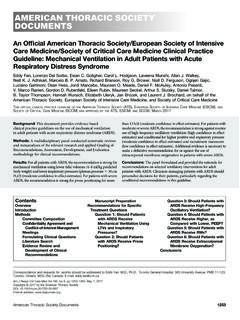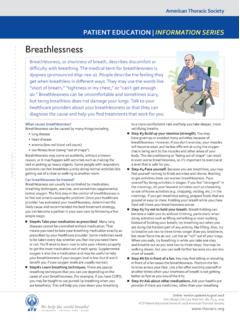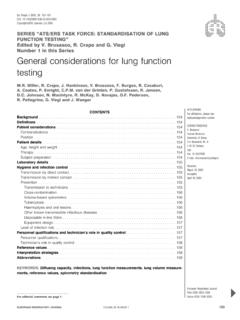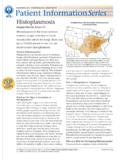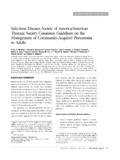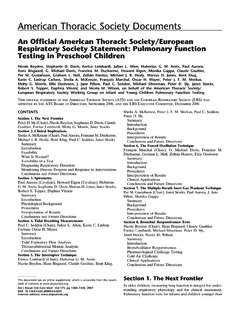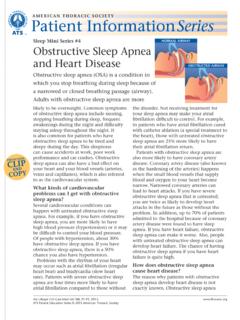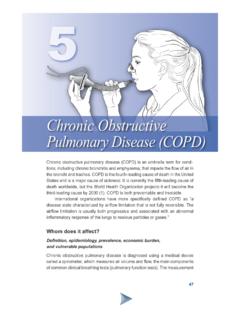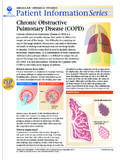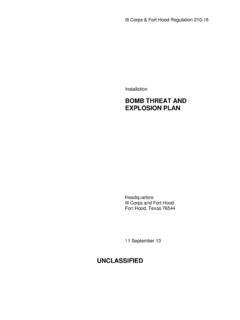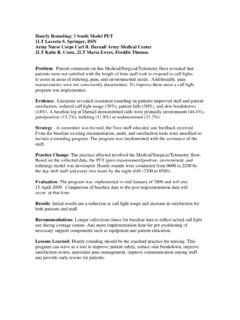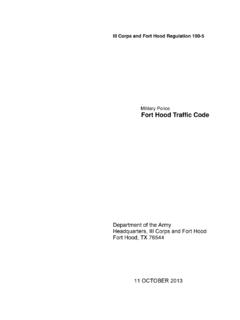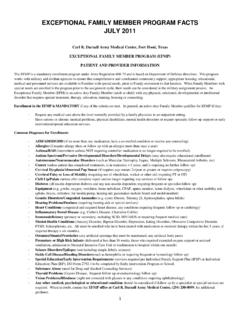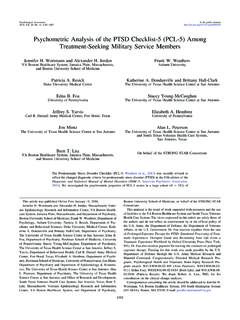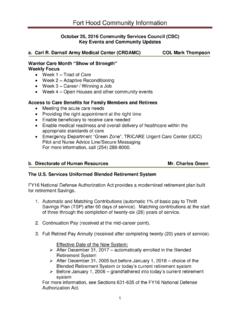Transcription of STudy of Active Duty Military for Pulmonary Disease ...
1 1 STudy of Active Duty Military for Pulmonary Disease related to environmental deployment Exposures ( stampede ) Michael J. Morris, MD, COL (Ret), MC, USA1 Darrel W. Dodson, COL, MC, USA2 Pedro F. Lucero, LTC, MC, USA1 Georgette D. Haislip, RRT, CPFT1 Roger A. Gallup, COL, MC, USA3 Karin L. Nicholson, LTC, MC, USA3 Lisa L. Zacher, MD, COL (Ret), MC, USA4 1 Pulmonary /Critical Care Service, Department of Medicine, San Antonio Military Medical Center, Fort Sam Houston, TX 2 Pulmonary /Critical Care Service, Department of Medicine, William Beaumont army Medical Center, Fort Bliss, TX 3 Pulmonary /Critical Care Service, Department of Medicine, carl R. Darnall army Medical Center, Fort Hood, TX 4 Orlando Veterans Affairs Medical Center, Orlando, FL Corresponding Author: Michael J.
2 Morris, MD Pulmonary Disease Service (MCHE-MDP) San Antonio Military Medical Center 3551 Roger Brooke Drive Fort Sam Houston, TX 78234 Office: (210) 916-3027 Fax: (210) 916-4721 Email: Michael J. Morris: STudy design, data analysis and interpretation, writing Darrel W. Dodson: STudy design, patient evaluation and data collection, writing Pedro F. Lucero: Data collection and analysis, writing Georgette D. Haislip: Data collection and patient evaluation Roger A. Gallup: Data collection, data analysis, writing Karin L. Nicholson: Data collection, patient evaluation Lisa L. Zacher: STudy design, data analysis, writing No external funding was received in the conduct of this STudy The opinions in this manuscript do not constitute endorsement by San Antonio Military Medical Center, the army Medical Department, the army Office of the Surgeon General, the Department of the army , Department of Defense, Veterans Affairs, or the Government of the information contained therein.
3 Page 1 of 28 AJRCCM Articles in Press. Published on 12-June-2014 as Copyright 2014 by the American Thoracic Society 2 Running Head: Pulmonary Evaluation for deployment Exposures Descriptor: Word Count: 3654 At a Glance Commentary This STudy represents the first prospective evaluation of new onset respiratory symptoms in deployed Military personnel. Most published literature currently describes increases in symptoms without determining underlying causes. It provides a more comprehensive evaluation of symptoms and determined that airway hyperreactivity is the most common finding identified in this population. Many individuals did not have a readily identifiable cause during their initial evaluation. Sleep and/or mental health disorders may play a role in their underlying respiratory symptoms.
4 Page 2 of 28 AJRCCM Articles in Press. Published on 12-June-2014 as Copyright 2014 by the American Thoracic Society 3 ABSTRACT Rationale: Due to increased levels of airborne particulate matter in Southwest Asia, deployed Military personnel are at risk for developing acute and chronic lung diseases. Increased respiratory symptoms are reported, but limited data exists on reported lung diseases. Objective: To evaluate new respiratory complaints in Military personnel returning from Southwest Asia to determine potential etiologies for symptoms. Methods: Returning Military personnel underwent a prospective standardized evaluation for deployment - related respiratory symptoms within six months of returning to their duty station. Measurements: Prospective standardized evaluation to include full Pulmonary function testing, high resolution chest tomography, methacholine challenge testing, and fiberoptic bronchoscopy with bronchoalveolar lavage.
5 Other procedures to include lung biopsy were performed if clinically indicated. Main Results: Fifty patients completed the STudy procedures. A large percentage (42%) remained undiagnosed including 12% with normal testing and an isolated increase in lavage neutrophils or lymphocytes. Twenty (40%) patients demonstrated some evidence of airway hyperreactivity to include eight who met asthma criteria and two with findings secondary to gastroesophageal reflux. Four (8%) additional patients had isolated reduced diffusing capacity and the remaining six had other miscellaneous airway disorders. No patients were identified with diffuse parenchymal Disease on the basis of computed tomography imaging. A significant number (66%) of this cohort had underlying mental health and sleep disorders.
6 Conclusions: Evaluation of new respiratory symptoms in Military personnel after service in SWA should focus on airway hyperreactivity from exposures to higher levels of ambient particulate matter. These patients may be difficult to diagnose and require close follow-up. Word Count = 250 Page 3 of 28 AJRCCM Articles in Press. Published on 12-June-2014 as Copyright 2014 by the American Thoracic Society 4 INTRODUCTION Concerns have been raised about health effects related to deployment of Military personnel to Southwest Asia (SWA) in support of combat operations during Operations Iraqi Freedom/Enduring Freedom (OIF/OEF). The effect of deployment on the respiratory health of Military personnel remains an Active issue1. These conflicts are unique due to environmental exposures from suspended geologic dusts, burn pits for waste disposal, and localized exposures such as the Al-Mishraq sulfur fire.
7 United States army environmental sampling demonstrated that Military personnel were exposed to increased levels of airborne particulate matter (PM) consisting primarily of geologic dusts exceeding current exposure guidelines2. Based on limited evidence, the Armed Forces Health Surveillance Center concluded there was no increased risk for respiratory diseases associated with exposure to burn pits3. The 2011 Institute of Medicine report also concluded increased PM was a concerning issue, but there was insufficient evidence of an association between exposures and Disease outcomes4. Documented increases in non-specific respiratory symptoms have been reported during SWA deployments. Survey research five years after the conclusion of the First Gulf War identified a modest correlation in self-reported symptoms of asthma and bronchitis in 1560 veterans, but findings did not correlate with modeled oil fire exposures5.
8 Initial results from a Navy survey of 15,000 Military personnel estimated that 69% of deployed personnel experienced respiratory illnesses, of which 17% required medical care6. Additional data from the Millennium Cohort STudy found deployed personnel had higher rates of newly reported respiratory symptoms than non-deployed personnel (14% vs. 10%), with similar rates of chronic lung disease7. A 2011 case series reported unusual findings among deployed soldiers from Fort Campbell with varied exposures to the Al-Mishraq sulfur fire; 78% (38/49) of patients who underwent surgical lung biopsy were reported to have pathologic evidence of constrictive Page 4 of 28 AJRCCM Articles in Press. Published on 12-June-2014 as Copyright 2014 by the American Thoracic Society 5 bronchiolitis (CB) described to involve a significant percentage of the small airways8.
9 Despite these findings, spirometry was generally normal with only 16% having obstructive or restrictive indices; chest radiography (CXR) was normal in 37/38 patients while high resolution computed tomography (HRCT) showed mild air trapping in 16%. An epidemiologic cohort STudy of 191 exposed soldiers, however, demonstrated no increase in post- deployment medical encounters among personnel exposed to the sulfur fire9. A 2010 Working Group on post- deployment respiratory issues recommended Pulmonary referral for chronic symptoms, reduction in exercise tolerance, abnormal Pulmonary function testing, comprehensive evaluation; and potential consideration for lung biopsy in patients on an individualized basis10. Due to predominantly retrospective studies and surveys with limited data on post- deployment respiratory Disease , the Department of Defense initiated clinical research studies to examine respiratory effects of deployment .
10 The objective of this STudy was to conduct a preliminary evaluation of returning Military personnel to establish etiologies for new onset respiratory symptoms after service in SWA. METHODS This prospective evaluation was approved by the Brooke army Medical Center Institutional Review Board (#363715) and all STudy participants provided written informed consent. Subjects were Active duty Military personnel recruited after deployment to Iraq/Afghanistan beginning in July 2010. All individuals had returned in the previous six months and reported new onset Pulmonary symptoms. Individuals with a pre- deployment medical history of Pulmonary or cardiac Disease were not enrolled. Participants first completed a deployment questionnaire detailing deployment history, airborne exposures, smoking, Pulmonary symptoms, and medical treatment.
